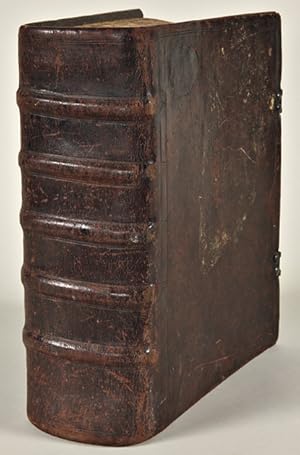bibel or bible or biblia (Mehr als 5.600 Ergebnisse)
Produktart
- Alle Produktarten
- Bücher (5.582)
- Magazine & Zeitschriften (1)
- Comics
- Noten (1)
- Kunst, Grafik & Poster (33)
- Fotografien (3)
- Karten
-
Manuskripte &
Papierantiquitäten (3)
Zustand
Einband
Weitere Eigenschaften
- Erstausgabe (157)
- Signiert (19)
- Schutzumschlag (207)
- Angebotsfoto (2.579)
- Kein Print-on-Demand (4.852)
Gratisversand
Land des Verkäufers
Verkäuferbewertung
-
Biblia, dat is, de gantsche H. Schrifture vervattende alle de boecken des Ouden ende Nieuwen Testaments.Including:(2) De Propheten.(3) De Apocryphe boecken: dat zijn boecken die der heylige schrifture niet en worden gelijck gehouden ende nochtans nut ende goet zijn om te lezen.Amsterdam, Rieuwert Dircksz. van Baardt (and his widow), printed on the presses of Lodewijk III Elsevier in Amsterdam, [1648]. 4 parts in 1 volume. Folio. With a full-page portrait of Martin Luther as a frontispiece, an engraved general title-page, a full-page portrait of Adolf Visscher, 6 folding double-page engraved maps, 6 double-page engraved plates showing a total of 96 biblical scenes (16 scenes per plate) printed by Frederick de Witt, and an elaborate engraved tail-piece. With three divisional typographical title-pages for the prophets, Biblical apocrypha and the New Testament, including Van Baardt's detailed woodcut vignette, decorated woodcut initials (at least 3 series) and ornamental woodcut tail-piece
Anbieter: Antiquariaat FORUM BV, Houten, Niederlande
Erstausgabe
[18], 278; 112; 70; 132 ll.First edition of this beautifully illustrated Dutch translation of the influential Luther Bible, with the engraved title-page, all plates and a large tailpiece expertly contemporary hand-coloured and strikingly highlighted in gold. This edition, published by (the widow of) Van Baardt, is also known as the "Visscher Bible", after its translator. It is certain that Visscher based his translation on Luther's original Bible and the two known Dutch translations: the "Lotter Bible" by Bugenhagen (1554) and the "Biestkens Bible" (1560). Apparently, Visscher did not use the new and by then already renowned Dutch States translation (commissioned during the Synod of Dordrecht in 1618-1619) and did not want to change Luther's original translation, which unfortunately resulted in a difficult to read work. Nevertheless, this became the standard Bible of the Dutch Lutherans. (Darlow & Moule).The present work was printed by Rieuwert Dircksz van Baardt (1599-1648) - according to I.H. van Eeghen - at the presses of Lodewijk III Elsevier (1604-1670). The work was published after Van Baardt's death by his widow and was illustrated with engraved maps by Nicolaes Visscher (1618-1679) after his father Claes Jansz. Visscher (1587-1652) and a complete series of Mattheüs Merian the Elder's (1593-1650) reduced scenes engraved by Cornelis Danckerts (1603-1656) and printed by Frederik de Wit (1630-1706) in Amsterdam. These two sets of engraved plates were published separately for the purpose of being added to Bibles such as the present one, or the Dutch States Bible for example. The illustrations are expertly hand-coloured and all highlighted in gold.With the small bookplate of Jan Willem Six de Vromade (1872-1936): "Ex bibliotheca J.W. Six" on the front paste-down. The binding shows very slight signs of wear, mainly around the spine, minor foxing and spotting throughout, mainly to the outer margins, with a ca. 4 cm tear in the foot margin of leaves a5 and a6 in the New Testament, without loss but slightly affecting the text, the last ca. 10% of the leaves show a very small (to max. ca. 1 cm in the last few leaves) wormhole in the gutter margin, barely affecting the commentary but not the main text. Otherwise in very good condition.l Darlow & Moule 3311; Poortman Bijbel en Prent I, pp. 137-139; STCN 089354303 (18 copies); WorldCat 68853298 & 67063785 (16 copies, including 8 also in STCN); cf. for the maps: Poortman & Augusteijn pp. 179-185 (maps 1,3 and 5 in their very first early state by N. Visscher, the others in the first state); for the small engraved scenes: Poortman, Bijbel en Prent I pp. 172-173 & II p. 66; for the portrait of Visscher: Muller Portretten 5690a; for the printing history: I.H. van Eeghen, La Bible luthérienne de 1648. Une édition Elevérienne inconnue , in : Studia bibliographica in honorem Herman de la Fontaine Verwey, Amsterdam 1966, 119-128.
-
La Biblia Que Es Los Sacros Libros Del Vieio y Nuevo Testamento trasladada en Espanol (by Cassiodoro de Reina)
Verlag: Basle (Basel, Basilea), 1569
Anbieter: Bath House Books, Ditchingham, Vereinigtes Königreich
Buch Erstausgabe
Full Calf. Zustand: Good/very Good. 1st Edition. 4to. 1569. The first edition of the complete Bible in Castilian Spanish by the Protestant convert Cassiodoro de Reina, banned by the Inquisition. Collates as DARLOW and MOULE 8472. Wanting the 2 blanks (1 between t.p. and dedication and the last a4 lf). but WITH the rare Annotationes, invariably wanting. Both copies cited by D & M are lacking the Annotationes. 'Many copies do not contain these additional notes, but that they properly belong to the volume is shown by a reference to them on the 11th page of the AMONESTACION'. (D & M). This copy exhibits D & M's variant B of t.p. with the device on the title representing a bear endeavouring to obtain honey from a hole in the trunk of a tree, hence this printing being known as the Biblia del Oso or The Bear Bible. Two large woodcut illustrations representing and explaining Ezekiel's vision. Apparently 2,600 copies printed but many were probably destroyed by the Inquisition who banned the translation. RARE. Only 1 copy in ABPC since 1976 (with lls in facsimile and wanting Annotationes). A nice clean worm-free, large-margined copy with minor marginal stain to the last 12 lls. T.p. a bit dusty. a.e.g. in full (probably 17th century) gilt panelled calf with handsome gilt central panel. Corners strengthened and recently respined to style.Wanting the 2 original leather ties. Cassiodoro de Reina was hounded out of Spain pursued by charges of heresy and homosexuality, ending up in Frankfurt am Main. Like the Luther Bible, the t.p. of Reina's edition cites Isaiah on the eternity of the Word of God but this time (defiantly) it quotes it in Hebrew. Images available on request.
-
BIBLIA. DAS IST: DIE GANTZE HEILIGE SCHRIFFT, ALTES UND NEUES TESTAMENTS. VERDEUTSCHT VON . . . MARTIN LUTHER
Verlag: J. A. Endter, Nuremberg, 1768
Anbieter: Phillip J. Pirages Rare Books (ABAA), McMinnville, OR, USA
454 x 282 mm. (17 7/8 x 11 1/4"). 18 p.l., 11, [51] leaves, 3-8 pp., [4], 9-190, [4], 191-740, [6], 512, 480 pp., [8] leaves. Three parts bound in one volume. SUPERB 1822 CALF, GILT AND INLAID IN THE ENTRELAC STYLE, BY J. H. STAFFEHL, covers with inlaid frame of green calf with gilt grapevine roll, center panel with intricate interlacing strapwork of inlaid green calf, five of the compartments formed by the straps with gilt sprays of wheat emerging from urns, raised bands, spine with inlaid green calf dividers, compartments gilt with large lozenge centerpiece of floral tools, floral vine cornerpieces, green calf labels, wide turn-ins framed by three decorative gilt rolls, inlaid green cornerpieces with sunburst, endpapers marbled to resemble tree calf, reinforced hinges, all edges gilt (older repairs to ends of joints). With 47 engraved plates, comprised of: copperplate portraits of Luther and 11 Electors; 11 section titles, each with 11 vignettes; nine full-page engraved depictions of Moses, Prophets, and the Evangelists; seven full-page plates engraved with 12 vignettes, six double-page maps, and two double-page engravings. Printed exhibition(?) card in old glassine envelope laid in at front, the text reading: "Meisterstück / des Hof-Buchbindermeisters / J. H. STAFFEHL zu Hannover. Angefertigt 1822" ["Masterpiece / of the court bookbinder / J. H. STAFFEHL in Hanover. Made in 1822"]. Jahn, p. 91. â A little rubbing to joints and extremities, tiny loss of gilt to centerpiece on upper cover, rear hinge with minor evidence of insect activity, the text with trivial imperfections, but A FINE COPY OF A STRIKINGLY BEAUTIFUL BOOK, the binding lustrous and solid, the contents clean and fresh. In a splendid binding by a royal bookbinder, this is as good a copy as one could hope to find of the last and most extensive edition of the very popular and sumptuous illustrated German Bible, known as the "Kurfürstenbibel" because of its portraits of the Electoral Princes (called "Kurfürsten" in German). It was originally prepared for Ernst I, Duke of Saxe-Gotha and Altenburg, as a celebration of Martin Luther's Bible translation, and all editions were printed by the Endters, one of the prominent German printing families, the first version appearing in 1641. In addition to portraits of Luther and the Protestant princes of Germany, it contains the maps, views, and illustrated half-titles by Jacob van Sandrart and others, first used in the edition of 1686, but the illustrated half-titles are here all signed by Johann Cristopher Claussner instead of the appropriate artists, and the views and other plates are lacking the signatures found in earlier states. The present copy contains four maps and views not found in other copies of this edition, showing the eastern Mediterranean and Palestine as well as both a map and a view of Jerusalem. Possibly from a 19th or early 20th century bindings or crafts exhibition, the card laid in here describes our binding as a "masterpiece," and that is in no way hyperbole. Remarkably elegant for such a massive tome, the delicately interlacing strapwork and the tasteful gilt tooling are expertly done, harking back to the lovely entrelac style of the 16th century. The binding is a memorable achievement, made all the more noteworthy in that it must have been executed relatively early in our binder's career. "Mittheilungen des Gewerbevereins für das Königreich Hannover: 1848/51" ["Communications from the trade association for the Kingdom of Hanover: 1848-51"] and both the 1856 and 1861"Hof- und Staatshandbuch für das Königreich Hannover" ["Court and State Manual for the Kingdom of Hanover"] list Staffehl as the court bookbinder. If he was still an active binder more than three decades after our binding was done, he can scarcely have been out of his twenties when he created this work. It would be an impressive achievement at any age, but is exceptional for one apparently so young. Such a large and impressively bound Bible would have been intended for use in a church--or perhaps a royal chapel, given Staffehl's association with the court.
-
Biblia sirech knigi vetkhago i novago saveta BIBLE
Verlag: Ostrog: Ivan Federov, 12 August, 1581
Anbieter: Konstantinopel ANTIQUARIAN BOOKSELLERS., ENSCHEDE, Niederlande
Hardcover. Zustand: Fine. [BIBLE, SLAVONIC] Biblia sirech knigi vetkhago i novago saveta. [Ostrog: Ivan Federov, 12 August] 1581. Folio (289 x 190mm). 628 lvs, but completed in manuscript with the title page and 9 lvs. index supplied in old expertly done manuscript (circa late 18th -early 19th century) with hand drawn arms of Konstantin Ostrozhkii on title verso, and Federov's hand drawn engraved device in colophon .Internally, title defective with small hole repaired. Handsome embossed early binding, evidence of clasps, hinges repaired with old strengthening on inner binding. Provenance: 1828 inscription to verso of last blank; Robert Pierpont Blake (1886 1950), renowned Byzantinist and scholar of the Armenian and Georgian cultures. Overall, a handsome copy Cyrillic Books 35; Darlow & Moule 8370 The first Slavonic Bible represents a monumental achievement in the cultural and linguistic history of the Slavic peoples, analogous to the transformative impact of the Luther Bible for German-speaking populations. This pioneering work was the product of Ivan Fedorov, a foundational =>gure in Russian publishing, who embarked on this endeavour under the patronage of Prince Konstantin of Ostrog. Prince Konstantin had secured a version of the Gennadius manuscript Bible, a signi=>cant text in its own right. In pursuit of this project, Prince Konstantin amassed an extensive collection of Greek and Slavonic manuscripts, as well as printed works. This library became the bedrock for Fedorov's translation eBforts. With meticulous care, Fedorov and his team scrutinized the Slavonic text against its Greek counterparts and, where available, Latin versions. This comparative study ensured that the translation was not only accurate but also resonant with contemporary linguistic usage. Archaic or ambiguous terms were replaced with modern equivalents, ensuring clarity and comprehensibility. In addition, any discrepancies or errors identi=>ed during this rigorous vetting process were recti=>ed. The signi=>cance of this =>rst Slavonic Bible cannot be overstated. It served as a standardizing force for the Slavic language, much as the King James Version did for English. Moreover, it played a pivotal role in religious and cultural spheres by making the sacred texts more accessible to the wider Slavic populace. The meticulous efforts of Fedorov, under the visionary leadership of Prince Konstantin, culminated in a work that was not just a religious tome but also a cornerstone of Slavic identity and heritage, as noted by bibliographic scholars Darlow & Moule. Please look at our new catalogue www.konstantinopel.nl.
-
1528 The Pagnini Bible First edition Original BIBLIA HABES IN HOC LIBRO prudens lector Sanctes Pagninus POST INCUNABULA Luther Tyndale Calvine
Verlag: Lyons, 1528
Anbieter: Miramar Antiques Art and Books Co. SL, MADRID, MAD, Spanien
Buch Erstausgabe
Cuero. Zustand: Bien. Zustand des Schutzumschlags: Bien. 1ª Edición. First edition of 1528, The Pagnini Bible was the first to divide the biblical text into numbered verses and one of the first revisions of the Latin Vulgate using the original languages. Sante Pagnini was an Italian monk and biblical scholar who eventually settled in Lyon, France. Like other scholars at this time, he became interested in studying the Bible in its original Greek and Hebrew sources. He completed his Latin translation in 1528, dividing his Bible into numbered verses for easier reference. His divisions, however, are different from the system used today, which was developed by Robert Estienne in 1551. Pagnini?s translation of the Old Testament was widely known for its literal reading of the Hebrew and remained popular until the end of the 1500s. Pagnino was born 1470 at Lucca, in Tuscany, central Italy. At sixteen he took the religious habit at San Domenico in Fiesole, where he studied under the direction of Savonarola and other eminent professors.[1] In acquiring the Oriental languages, then cultivated at Florence, he displayed unwonted quicksightedness, ease and penetration. His genius, industry and erudition won him influential friends, among them the Cardinals de'Medici, subsequently popes Leo X and Clement VII. As a sacred orator his zeal and eloquence kept abreast with his erudition and were as fruitful. Summoned to Rome by Leo X, he taught at the recently-opened free school for Oriental languages until his patron's death (1521). He then spent three years at Avignon and the last seven years of his life at Lyon. Here he was instrumental in establishing a hospital for the plague-stricken, and by his zeal and eloquence, diverted an irruption of Waldensianism and Lutheranism from the city, receiving in acknowledgement the much coveted rights and privileges of citizenship. Here he also was in contact with the polymath and Hebraist Michael Servetus, whom he gave his notes to, and designated him as his heir to the scholarly study of the bible after he would have died. The epitaph of Pagnino, originally adorning his tomb in the Dominican church at Lyon, fixes the date of his death on 24 August 1541, at Lyon, beyond dispute. 24, 5 centimetros 29 hojas sin numerar +1-135 + 1-98 foliadas + 70 sin numerar. A dos columnas, excepto las 29 hojas preliminares y las Epistolas de Sanctes Pagninus, que inicia la tercera parte del volumen, letra redonda iniciales grabadas en madera. Titulos corrientes sin reclamos. Portada Orlada dos tintas, roja y negra. Breve de Adriano Vi (Roma 11 de mayo de 1523) por el cual concede licencia a Sanctes Pagninus, O.P para imprimir como se proponía. Id de Clemente VII (roma, 6 junio 1526) de análogo tener, licencia de la orden de los Predicadores, Bible in Latin, trans. Sanctes Pagninus BIBLIA. HABES IN HOC LIBRO PRUDENS LECTOR VTRIUSQUE INSTRUMENTI NOUAM TRANSLATIONEM AEDITAM À REUERENDO SACRAE THEOLOGIAE DOCTORE, SANCTE PAGNINO LUCENSI PRAEDICATORIJ ORDINIS . LYONS: ANTONIUS DU RY FOR FRANCESCO TURCHI, DOMENICO BERTICINIO AND JACOPO GIUNTA, 29 JANUARY 1527/28 (TITLE-PAGE: 1528) Super-Median quarto (238 × 174 mm). Collation: a-c8 d6 (title with Giunta device, Greek commendatory verse, commendatory letters of Adrian VI, Clement VII, and Gianfrancesco Pico della Mirandola, contents summaries of Old Testament books, prologue); A-Z AA-PP8 (Hebrew Old Testament books, Genesis-Malachi); QQ-XX8 YY4 (Greek Apocrypha: Tobit, Judith, Wisdom, Ecclesiasticus, Baruch, 1-2 Maccabees); a-l8 m10 (New Testament; colophon); n-v8 x6 (Interpretations of Hebrew Names): 554 leaves, PP8 and YY4 blank. Old Testament foliated 1-355; New Testament foliated [1] 2-98. Red and black printing, woodcut title border, woodcut initials. Leaves browned, with soiling, three leaves with strengthened inner margins. Seventeenth-century vellum, red-sprinkled edges. Leaves browned, with soiling, three leaves with strengthened inner margins. First edition of Pagnino?s translation, with chapters divided into numb.
-
Biblia latina postilis Nicolai de Lyra et expositionibus Guillelmi Britonis in omnes prologos S. Hieronymi.
Verlag: Venetijs [Venice], per Franciscum Renner de Heilbrun 1482., 1482
Anbieter: Antiquariat Burgverlag, Wien, Österreich
3 Bde. gr.-4°. 30, 5 x 21, 5 cm. (Blattgr.), 25, 5 x 15, 5 - 16, 5 cm. (Satzspiegel). 1209 (st. 1211 bzw. 1361) nn. Bll. in 2 Spalten, 60 bzw. 73 Zeilen. Got. Type. Geflammte HLdr.-Bde. d. 19. Jhdts. mit aufgesetzten, abgefassten Holzdeckeln. Sehr gut erhaltenes, breitrandiges Exemplar. Mit zahlreichen, teils mehrere Zeilen umfassende, Initialen in Blau und/oder Rot. Im ersten Band lediglich die Blätter aa3-bb5 mit stärkerer Wasserspur im unteren weißen Rand und die letzten 30 Blätter mit kleiner Wurmspur unten beim Gelenk. Die ersten Blätter im zweiten und dritten Band etwas fleckig bzw. mit Wasserspur im Rand. Holzdeckel teils mit kleinen Kratzspuren. Hain-Coppinger 3165; GW 4287; BMV V, 197; BSB-Ink. B-447; ÖNB-INk. B-394 - In drei Bänden gebundener vierter Bibeldruck mit den Postillen des französischen Theologen und Franziskanermönches Nicolaus de Lyra (1270-1349). De Lyra studierte in Paris. Sein ausführlicher Bibelkommentar, der Bezug auf jüdische Traditionen wie von Raschi nimmt, wurde auch von Luther geschätzt und benutzt. Im Anhang seine kurze Schrift `Contra perfidam Iudeaeorum`(69-4 bis 69-9). Ohne die 1483 erschienenen, meist fehlenden `Additiones` von Paulus v. Burgos (1352-1435) (2, 148 Bll.) und ohne die beiden weißen Blätter (a1 im ersten und 69-10 im dritten Band). Mit einigen zeitgen. handschriftl. Anmerkungen und Diagram in brauner Tusche. Fourth printing of the Bible bound in three volumes with the postils of the French theologian and Franciscan monk Nicolaus de Lyra (1270-1349). Very well preserved copy with wide margins. With numerous initials in blue and/or red. In the first volume only the leaves aa3-bb5 with stronger water trace in the lower white margin and the last 30 leaves with small worm trace below at the joint. The first leaves in the second and third volume somewhat stained and with water trace in the margin. Wooden boards partly with small traces of scratching. - De Lyra studied in Paris. His extensive commentary on the Bible, which makes reference to Jewish traditions such as those of Rashi, was also appreciated and used by Luther. In the appendix his short writing `Contra perfidam Iudeaeorum` (69-4 - 69-9) . Without the often missing `Additiones` by Paul v. Burgos (1352-1435) (2 w. and 148 leaves), published in 1483, and without the two white sheets (a1 in the first volume and 69-10 in the third volume). With some contemporary handwritten annotations and diagram in brown ink. Gewicht in Gramm: 6000.
-
Biblia, das ist: Die gantze heilige Schrifft, verdeutschet durch D. Martin Luther [.].
Verlag: Lüneburg, Johann Stern, 1685., 1685
Anbieter: Antiquariat INLIBRIS Gilhofer Nfg. GmbH, Vienna, A, Österreich
12mo (70 x 130 x 65 mm). (8), 664 pp. 423, (1) pp. 302, (5), 5, 8 pp. With engraved frontispiece and 3 engr. title-pages. Contemporary brown calf. Marbled endpapers. All edges gilt. Pretty Lüneburg-printed Luther Bible in small pocket format, bound as a "dos-à-dos-à-dos binding", a superlative triplet version of the dos-à-dos binding. The latter is described as "a binding structure in which two separate books are bound together such that the fore edge of one is adjacent to the spine of the other, with a shared lower board between them serving as the back cover of both". Von Arnim states that "this gimmick first seems to have appeared in the 1560s [.] Gruel noted that these curious bindings almost exclusively contain Protestant functional writings. It would seem that sober Protestantism here yielded to a luxurious whim, as it were, a substitute for the Catholics' bibliophile Books of Hours. Dos-à-dos bindings were particularly popular in England, especially for the small-format editions of the New Testament and Psalms so common there [.] Of nine dos-à-dos bindings in the British Museum, six are embroidered" (Bibl. Otto Schäfer, no. 79). "These twin bindings, or dos-à-dos bindings, were used frequently for religious books of the 17th and 18th century, but very few have survived" (Sonntag, Boerner Cat. 21, no. 63: an embroidered English dos-à-dos binding). Bound between the first and second parts (Genesis through Song of Solomon; Prophets) is the third part (New Testament), with shared inner boards. A few old ms. notes; first part wants flyleaves. Some professional repairs to the binding's extremeties. - VD 17, 23:672727F. Darlow/Moule 4221. Württ. Bibelslg. E 906 (dos-à-dos binding; Josias Lorck copy).
-
BIBLIA LATINA. - Biblia breves in eadem annotiationes, ex doctiss. interpretationibus, | Hebraeorum commentaries
Verlag: Antwerp: A. Goinus, 1540
Hardcover. Zustand: Good. Antwerp, A. Goinus, 1540. [8p], 416p, [31p], 60p. RARE ANTWERP BIBLE. Remarkable German binding; contemporary blind-rolled pigskin over wooden boards with the portraits of the prince-elector Johann Friedrich von Sachsen, the emperor Charles V, the reformers Luther, Melanchton and Erasmus, two brass clasps. Black tooled text on the first cover: "Sacra Biblia 1541 Joannes v. Busck". First cover and first part (150p) of the book wormed. Folio. (39.5 x 27 cm) Nijhoff-Kronenberg, 356 (4 copies - 1 copy in Belgium (Westmalle, Cisterc.)); Bibles BN Paris, 837; Adams, B1023; Not in STC Dutch;
-
(Bible in Latin). Bibliorum opus sacrosanctum Vulgatis quidem characteribus, sed incredibili studio diligentiaque ad primaeuum receptem per Ecclesiam Romanam aeditionis candorem revocatum.Que praeterea modum in tam arduo negocio tenuerimus, primus statim quaternio patefaciet.
Verlag: Lugdunum LyonJean Mareschal ., 1532
Anbieter: Robert Frew Ltd. ABA ILAB, London, Vereinigtes Königreich
Buch
Large folio (43.5 x 23 cm). ff.[8]+276+[24]. Full eighteenth-century bluish green French morocco, sides ruled with gilt foliate border, spine with raised bands and lavishly gilt in compartments, each with central fleuron device, red morocco label lettered in gilt, the edges of boards decorated with gilt roll, marbled endpapers, all edges gilt. Title-page printed in red and black along with the tables of canons. Latin text printed in double and triple column within printed border. Title-page with elaborate woodcut borders and vignette of St. Jerome in his study, full-page woodcut illustration of God creating the earth at the head of the Old Testament (captioned 'Opus sex dierum'), three-quarter woodcut depicting the Nativity scene at the head of the New Testament, half-page woodcut of King Solomon at the head of proverbs, 112 woodcut vignettes and numerous additional woodcut initials in the text. Engraved bookplate of "L'Olivette" with "G.O." monogram to front pastedown, the bookplate engraved by Silvain Guillot (a Parisian armorial engraver) to front pastedown along with a small library shelf mark. Title-page bears the old ownership inscription of the Jesuit College in Antwerp; in the same hand are an additional 5 instances of marginal annotations (on ff. 2r, 57v, 141v, 156v, and 175v). Minor shelfwear, internally generally very good but with some light occasional damp-staining, four small marginal holes on E7 (not affecting the text), and some repairs to edges of the last few leaves, overall a well-illustrated edition of the Vulgate in a superb French binding. Mareschal's Bible was the first to include the Third Book of Maccabees, an addition which resulted in his later condemnation by the Council of Trent (which declared the book to be apocryphal), forcing him to flee to Switzerland and subsequently to take up permanent residence in Heidelberg. The woodcut of the Nativity scene is a close copy of Hans Springinklee's woodcut which first appeared in a 1517 prayer book before being used for the 1520 Lyon edition of the Bible (Mortimer, Harvard French 63) as well as Luther's 1524 German Translation of the Old Testament, with a different artist's monogram. The smaller woodcuts are more simplistic copies of those found in other Lyon bibles from this time produced by Mareschal, Crespin and Sacon (such as Mortimer, Harvard French 66, Crespin's 1529 Bible). USTC locates 15 copies, all in Europe save for 2 copies in the UK. Adams, 1012.
-
Biblia, Dasist: Die Helige Schrift Altes un Neues Testaments, Nach der
Erscheinungsdatum: 1743
Anbieter: G.S. MacManus Co., ABAA, Bryn Mawr, PA, USA
(SAUR BIBLE). Biblia, Das ist: Die Helige Schrift Altes und Neues Testaments, Nach der Deutschen Uebersetzung D. Martin Luthers mit Jedes Capitels Furtzen Summarien, Ach Bengefugten Vielen und Richtigen Parallelen; Rebst dem Gewohnlichen Anhang des Dritten und Vierten Buchs Esra und des Dritten Buchs der Maccabaer. Germantown: Christoph Saur, 1743. 4to. [4], 995. [1], 277, [7] pp. printed in double columns. Ornamental capitals. Contemporary calf over bevelled wooden boards, tooled brass clasps, raised bands. Repaired, loss to foot of spine made up in matching leather; lower half of second column of one leaf expertly supplied in facsimile; boards rubbed; toning and light scattered foxing, else a very good copy. Evans 5127. Darlow & Moule 4240. Hildeburn 804. The first European language bible printed in America, and the second bible printed in America after John Eliot's Indian bibles of the 1660s. The text is based on Martin Luther's version by way of the 34th edition of the Halle Bible, with books three and four Esra and three Maccabees supplied from the Berlenburg Bible. Believed to have been printed in an edition of 1200 copies, of which slightly over one-tenth are known to have survived. Christoph Saur was a native of Wittgenstein, Germany, who settled in Germantown, Pennsylvania, and practiced medicine before turning to printing. A very nice copy of a landmark in American religious and printing history.
-
BIBLIA, Das ist: Die gantze Heilige Schrifft Altes und Neues Testaments. Verdeutscht von . Martin Luther: Und auf . Verordnung . Ernsts, Herzogen zu Sachsen . von etlichen reinen Theologen . erkläret . Von neuem mit Fleiss übersehen . und . vermehret. 2 parts in 1 vol.
Verlag: Nuremberg, J. A. Endter, 1720
Anbieter: Hellmut Schumann Antiquariat, Zurich, Schweiz
Erstausgabe
With engr. illus. title, 12 full-page engr. portraits by J. C. Claussner, 9 plates with portraits of biblical figures, 4 double-page maps with fine baroque cartouches and illustrations, 2 double-page plans, 21 engr. pictorial titles and plates (some double-page and folding), several woodcut initials and vignettes. 2 cols. Printed title in red and black; 67 unn. leaves, 664 pp.; 904 pp., 8 unn. leaves. Large folio. Contemporary calf in the style of Swedish gilt leather bindings, richly gold-tooled in a panel design with flowers and ornaments, flower tool in center and corners of frames, both covers lettered each with 2 Bible quotations, spine on raised bands with richly gilt rococo ornamentation in compartments, 2 brass clasps (new ties), goffered edges, marbled end- papers, all edges gilt (slightly restored). Nuremberg, J. A. Endter, 1720. A beautiful example of the so-called "Kurfürsten Bible", also called "Weimar Bible" or "Ernestinian Bible", Present here is a copy of the 12th edition, this Bible appeared until 1768. Its first printing, commissioned by Duke Ernest the Pious of Saxe-Weimar, was in 1641. Editors were Johann Gerhard (1582-1637), theologian at Jena, and his successor Salomon Glassius (1593-1656), a.o. It was the most popular German Bible of its time, using Luther's text of 1545 and including the Apocrypha. There is a glossary, and each chapter is accompanied by texts from S. Glassius' "Biblisches Handbüchlein" meant as a help for the lay reader. A detailed history of the conception and printing of this epochal Bible is given in the preliminaries. This edition contains a wealth of pictorial matter, the title showing Moses and Christ to the left and right of the pillars of a temple, which bears the coat of arms of the Duke. It is followed by the portraits of the Saxon electors with their coats of arms, and Martin Luther: some engravings include small views, More than 30 full-page plates show biblical characters like Moses, Isaiah, Ezekiel, Daniel, and the 4 evangelists, Noah's ark, 2 plans of Jerusalem, 4 maps, 1 folding plate showing camps of the Israelites. 18 plates serve as titles to various books of the Bible, with scenes from the following contents in 12 small compartments. The last illustration is the double-page picture of the presentation of the Augsburg Confession to Charles V (1530), the full text of which is included. - Slight browning or foxing in parts, some wormholes and tears repaired. Fine copy in a rare, nice binding, engravings in dark impressions. - Bibelsammlung Stuttgart E 1198; Jahn 79ff.; cf. Graesse I, 379; this edition not in Darlow/Moule, Lüthi, etc. BIBLES ; KURFÜRSTENBIBEL ; RELIGION / THEOLOGY ; ILLUSTRATED BOOKS (BEFORE 1900) ;
-
Biblia Das ist die gantzeSchrifftAlten und Newen Testaments Verteutscht: Durch Dr. Martin Luther Jetzundt Nach dem letzten in Anno 1545 bey des Authoris Lebzeiten ausgangenen Exemplar
Verlag: Lazari Zetzner Seligen Erben, Straßburg, 1630
Anbieter: Hans H. Althaus, Göttingen, NDS, Deutschland
Buch Erstausgabe
Leder. Zustand: Gut. Matthias Merian (illustrator). 1. Auflage. Buchformat: in Leder gebunden, 1.Aufl., Straßburg, 1630, Lazari Zetzner Seligen Erben; 5 Bünde mit Titel und floralem Schmuck in Gold; Folioformat (37,5cm x 26cm x 9,5cm); rundum mit rotem Farbschnitt; Seiten: 3 gestochene Titel; 235 Textkupfer (Matthias Merian); An den Christlichen Gottliebenden Leser der H. Schrifft (Lazari Zetzner S. Erben); Vorrede auff das Alte Testament; Register der Historien und Erklärung der frembden Namen; Register der fürnembsten Hauptartikel Christlicher Lehre; Chronologia oder Zeitregister .; Register und Verzeichnis .; Register der Episteln und Evangelien, die man. Verzeichnis aller Bücher des Alten und Newen Testaments: Das Alte Testament: 346 Bl., Andern Theils des Alten Testaments incl. Apocrypha: 222 Bl.; Das Newe Testament: 168 Bl.; Blatt 167 mit Sprung auf p. 268; Sprache: Deutsch; Gewicht: ca. 5500 g Buchzustand: berieben und bestossen; 8 Bl. 'angefasert' (6 Bl. vorne u. 2 Bl. letzte Seiten), keine Beeinträchtigungen der Merian Bilder; letzten 2 Seiten Auszug von Johann Henrich Badenhaussen, 1789 ff.; Gesamtzustand: gut.
-
Biblia, Das ist die gantze Heilige Schrift, Altes und Neues Testaments. Verdeutscht von Herrn Doctor Martin Luther: Und auf gnädigste Verordnung Des Durchlauchtigsten Fürsten und Herrn, Herrn Ernsts, Herzogen zu Sachsen, Fülich, Kleve und Berg von etlichen reinen Theologen dem eigentlichen Wort-Verstand nach erkläret, wie hiervon weiter in der Vorrede gehandelt wird. daher über die gewöhnliche, mit Fleiß verbesserte Biblische Register, unter anderem zu finden, ein Bericht, von Vergleichung der Jüdischen und Biblischen Monden, Maaß, Gewicht, Müntz und Elen mit den Unserigen: Sowohl auch eine Beschreibung der Stadt Jerusalem, samt unterschiedlichen neuen Land-Tafeln, und andern schönen Kupffer-Figuren, und derselben Beschreibung: Welches alles dem Christlichen Leser, zu mehrerm Verstand der Schrifft, gute Anleitung geben kan. Zu Ende ist auch, nebst den Christlichen Haupt-Symbolis, die unveränderte Augspurgische Consession mit beygedruckt worden.Von neuem mit Fleiß übersehen, durch ferne
Verlag: In Verlegung der Johann Andrea Endterischen Handlung, Nürnberg, 1768
Anbieter: ERIC CHAIM KLINE, BOOKSELLER (ABAA ILAB), Santa Monica, CA, USA
Erstausgabe
Hardcover. Zustand: vg. Folio (17 3/4 x 12"). [2] leaves (Half-title and title), [12]pp (Preface of the 1736 second edition), [2]p (Note to the Christian reader on this new 1768 edition), [16]pp (Preface to the 1640 [i.e. 1641] edition), [2]pp (List of Saxony's Electors), 11 leaves (Engraved portraits of the Electors), [1] leaf (Engraved portrait of Martin Luther), [8]pp (Short introduction and instruction regarding the Holy Scriptures), [2]pp (Calendar), [13]pp (Index), [26]pp (Name Index), [11]pp (Chronology), [1]pp (Personalities in Maccabee and Herodium), [7]pp (Explanations on the Old Testament), [5]pp (Charts of calendars, weight, money, measures and distance used in the Bible), [4]pp (Chronological order of the Books of the Bible), [7]pp (Register / Table of the Old Testament), [3]pp (Preface of the Old Testament by Martin Luther), [3] leaves (Engraved plates), 740pp (Old Testament). [1] leaf (Engraved title of the Prophets), [1]-328pp (The Prophets), [2] leaves (Engraved title for Apocrypha, and plate), 329-512pp (Apocrypha), [4] leaves (Engraved title and three plates for The New Testament), 472pp (New Testament), 473-480pp (Constitution and harmony of the Gospels), [8]pp (Detailed plans of Jerusalem), [14]pp (Confessio). Richly gold-tooled calf with spectacular foredges stamped & tooled in gold. Foredge shows a sunburst with architectural motifs. Top and bottom edges with architectural motifs only. Front and back board with brilliant gold-tooling of a Greek temple, small motifs on top and bottom representing the seats for the bishops, all within amazingly detailed gold-tooled border. Rebacked, retaining original spine. Dentelles. Engraved half-title by J. C. Claussner, preceded by the printed title. Decorative head-, tailpieces and initials. In 1641 was published the first edition of the so-called "Weimar Bible" compiled under the auspices of Ernest, Duke of Saxony-Jülich-Cleves-Berg, by Johann Gerard, Salomon Glass and others. This striking 1768 copy is the third and last edition of the "Weimar Bible" also called "Kurfürstenbibel" (the Electors' Bible) as it features eleven full page engravings depicting Saxony's Electors from Friedrich III to Bernhard der Große (plates numbered 1-11), followed by an engraved portrait of Martin Luther. (see Darlow & Moule 4217 for the 1641 edition and Darlow & Moule 4234 for the 1768 edition). This Bible was published with added in-text explanations of Luther's original translation to better facilitate the understanding of the biblical text. Illustrated with 49 plates (including 12 engraved titles and inter-titles), most of them are full-page engravings (29), with 4 double-page, as well as 4 double-page maps and plans. With the rare fold-out engraving at rear showing the royal entourage in the large reception hall during the "Confessio"* which took place in Augsburg in 1530. Individuals and parts of the architecture in the hall are identified on the actual plate with small numbers ranging from 1 to 47. The opposite page lists each number with the name and title of the person depicted as well as explanations of parts of the architecture. This plate is usually missing in most copies. Small area on rear of the plate has been expertly repaired. All engravings in this bible are by Clausner. Engraved titles and decorated initials throughout. Minor age wear to binding. Some staining to endpapers. Last page chipped on bottom edge not affecting text. Slight staining and foxing to few pages. Text in German, Gothic script. Tight copy in a stunning binding with exquisite illustrated page edges. In overall very good condition. Darlow-M. 4234 for 1736 edition. * The Augsburg Confession, also known as the "Augustana" from its Latin name, Confessio Augustana, is the primary confession of faith of the Lutheran Church and one of the most important documents of the Lutheran Reformation. The Augsburg Confession was written in both German and Latin and was presented by a number of German rulers and free-cities at the Diet of Augsburg on 25 June 1530. The Holy Roman Emperor Charles V had called on the Princes and Free Territories in Germany to explain their religious convictions in an attempt to restore religious and political unity in the Holy Roman Empire and rally support against the Turkish invasion. It is the fourth document contained in the Lutheran Book of Concord. Third and last edition of the Weimar Bible.
-
Biblia Das ist: die gantze heilige Schrift/ Deutsch D Mart. Luth. Wittenberg, Säuberlich 1599.
Verlag: Wittenberg, Lorenz Säuberlich, 1599., 1599
Anbieter: Fontane-Antiquariat Dr. H. Scheffers, Berlin Schöneberg, BLN, Deutschland
2 Teile in 1 Band. 332 und 372 gez. Blatt. Mit ca 230 kolorierten Textholzschnitten (je 11 x 15 cm quer) von Johann Teufel (u.a.), 1 kolor Wappentafel (Eckausriß ohne Verlust), 1 Druckermarke und 41 gezählte kolor. Tafeln mit Abb.von Herzögen und hochgestellten Damen (Taf. Teils läd.). Folio (35 x 24 x 10 cm). Leder d. Zeit über Holzdeckeln (die Deckel gelöst, s. Einbandzustand teilw. bei Beschreibung unten). Bibl.: H.Volz (1954) p.160, Nr.59. - Ph. Schmidt, Die Illustration der Lutherbibel, S.274-296, mit 19 s/w Abbildungen.- Vgl. Reinitzer, Kat.40: Biblia deutsch, HAB 1983/84, Nr 158. - -- (Erweiteter) Wittenberger Druck dieser "Prachtbibel" (Schmidt) mit den Bildern von Johann Teufel nach den Ausgaben bei Krafft Wittenberg 1572 u. 1584. "Die Illustrationen von Johann Teufel sind aus einer tiefen Kenntnis der Bibel, besonders der israelitischen und jüdischen Geschichte hervorgegangen. Der Künstler bringt sie immer wieder mit seiner Zeit in Verbindung: mit dem Widerstand gegen die wachsende Gegenreformation, seiner Treue zu Luther und der noch nicht fernen Zeit der Reformation.Es ist im Grunde die Gesamtheit jener Bilder, vorab die Wahl der dargestellten Stoffe, die das Glaubenszeugnis jener Zeit so eindrücklich macht" (Schmidt, p.277). Bei Schmidt aufgezählt auch die exemplarische Beschreibung jener Bilder von Teufel, die nie gesamt in einer Bildfolge gedruckt wurden, aber in der Bibelillustration einzig sind: z.B. wie Ismael den Isaak verspottet, - den Felsen, woraus Mose Wasser schlägt, als Christus! , - Götzenpriester als tonsurierte, fette Pfaffen,- die Hexe von Endor als heimliche Katholikin! (p.276). Daneben die berühmte Darstellung Luthers mit dem Kurfürsten Friedrich dem Weisen bei der Zerschlagung der Götzen (1.Könige 15). - Die Offenbarung Johannis umfaßt allein 22 überwiegend prachtvoll kolorierter Holzschnitte! - -Das Format aller Textholzschnitte 11 x 15 cm entspricht dem der Cranach-Bibel von 1534. - - - Der Wert des vorliegenden Exemplars liegt in der Fülle der fast durchweg prachtvoll kolorierten und farbfrisch erhaltenen Holzschnitte, teilweise goldgehöht und fast vollzählig. --- Eine Aufstellung von Erhaltungsmängeln des Buches sowie einiger Holzschnitte etc. ist hier aus Platzgründen nicht möglich, aber auf Anforderung gerne erhältlich. Ebenfalls über den äußeren Erhaltungszustand des fast 6 kg schweren Buches (läd. Einband, lädiertes vorgeschaltetes Register u.ä.), dem wohl schon der 30jährige Krieg mitgespielt hat. Aber: zeitgenössisch kolorierte Exemplare der Teufel-Bibel, zumal so prachtvoll farbfrische wie das vorliegende, sind äußerst selten! - One of the most beautiful illustrated - coloured! - bibles in the age of Luther.
-
Biblia, das ist: Die Heilige Schrift Altes und Neues Testaments. Nach der Deutschen Uebersetzung D. Martin Luthers mit Jedes Capitels Furtzen Summarien, Ach Bengefugten Vielen und Richtigen Parallelen; Rebst dem Gewohnlichen Anhang des Dritten und Vierten Buchs Esra und des Dritten Buchs der Maccabaer.
Verlag: CHRISTOPHER SAUR, GERMANTOWN, 1743
Anbieter: Dungeness Books, ABAA, Sequim, WA, USA
Buch Erstausgabe
Hardcover. Zustand: Very Good. 1st Edition. Summary: Germantown: Christoph[er] Saur, 1743. 4to (9.5 X 7.5 in). The first Bible printed in America after the Elliot Indian Bible of the 1660s, and the first American Bible printed in a European language. A very good copy in original beveled boards. Description: There are several clippings pertaining to this edition of the Bible mounted on the front pastedown. Printed general title page (1743) laid down with loss to the lower border and imprint, which have been replaced in facsimile. Ornamental headpiece at the beginning of Genesis. Text in two column black letter, with cross references and short summaries at the beginning of each chapter. The text is based on Martin Luther's version by way of the 34th edition of the Halle Bible, with books three and four Esra and three Maccabees supplied from the Berlenburg Bible. The present copy has "parallelen" spelled correctly (a second issue of the title had this word misspelled as "parllelen" as it was made in haste.) Printed New Testament title page (1743). Ornamental headpiece at the beginning of Matthew. Concludes with a Register (3 pp.). Collation: *^2, A-Z^4, 2A-2Z^4, 3A-3Z^4; 4A-4Z^4; 5A-5Z^4, 6A-6I^4, 6J^2 (Old Testament); A-Z^4, 2A-2M^4, 2N^2 (New Testament). Lacks Rrr-Sss (Psalm 23-56). Binding: Period full sheep over beveled oak boards. Sometime expertly rebacked with the original spine laid on. A portion of one strap perished, with the original hasp and other strap remaining. Binding chipped in various places, but nicely restored. Condition: Some dampstaining in places, most prevalent to first few leaves; some toning, occasional soiling and spotting, as typical; small hole to final leaf with loss of a few letters; a few instances of shaved catchwords in places; introductory leaf remargined with loss of a few letters to margins. Note: 1200 copies of this Bible were printed by Christopher Saur. He was a man of conviction in matters of morality and religion, and he sought to produce a Bible that his fellow Germans could read in their native tongue. He appealed to Germany where Dr. Heinrich Luther provided him with the type, in exchange for a presentation copy. It took him three years to complete the printing of the Bible. Saur made every effort to promote the reading of the Scriptures. His asking price was eighteen shillings but his quoted as saying that to the poor and needy we have no price. An estimated 120 copies have survived, making copies of the 1743 edition quite scarce. References: D&M 4240; Evans 5127; Wright 31.
-
Biblia. das ist: Die gantze heilige Schrifft: Deudsch. D. Mart. Luth. [Luther Bible]
Verlag: Wittenberg: Hans Lufft, 1562
Anbieter: Stony Hill Books, Madison, WI, USA
Buch
Hardcover. Zustand: Very Good. This is a 1562 edition of the Luther Bible; folio measuring approx. 14x9 inches, bound in blind-stamped leather-covered boards [in the style of the 16th century tawned pigskin bindings, though the leather is browned and has the look of calfskin], brass corners and clasps, all many times repaired over the years [photo]. Conforms to OCLC Number / Unique Identifier: 9085033329, thus foliated [6], 289, [1] blank, 307 leaves, LACKING leaves 308-326 [leaf 307 is numbered "370" with other errors also found]. Initial title page in red and black, title page of the second section "Die Propheten alle Deudsch" in black. Numerous wood-engraved illustrations, binding square and tight, old ownership on pastedown, including one dated 1564. Please ask any questions, additional photos on request. A digital copy of this work can be found at the Martin Luther library of the university of Halle-Wittenberg. NOTE: our copy is NOT colorized. Paginates complete except as noted above, lacking the final 19 leaves.
-
BIBLIA DAS IST: DIE GANTZE HEILIGE SCHRIFFT. DEUDSCH. D. MARTIN LUTHER. [THE GERMAN BIBLE IN LUTHER'S TRANSLATION]
Verlag: Bremer Presse 1926-28, Munich, 1926
Anbieter: Phillip J. Pirages Rare Books (ABAA), McMinnville, OR, USA
ONE OF 365 COPIES. 360 x 250 mm. (14 1/4 x 10"). Five volumes. Edited by Carl von Kraus. VERY FINE TAN MOROCCO BY WERNER G. KIEßIG (stamp-signed with his "K" mark at foot of lower cover), upper covers lettered in blind, lower cover with small round book stamp of former owner Martin Wandersleb, smooth spines divided into panels by blind rules, blind-stamped titling, marbled endpapers, leather hinges, top edges black, other edges untrimmed. In the original brown dust jackets with paper title labels to spines. Housed in the original (slightly worn) matching marbled paper slipcases. With titles and initials drawn by Anna Simons. Front pastedown with bookplate of Martin Wandersleb. Eyssen 88; Ransom, p. 257. â One or two faint spots of foxing, one small marginal smudge, but A CHOICE COPY, with no signs of use inside or out. This is a superb copy of the signal achievement of the Bremer Presse, in a restrained but impressive binding produced by Berlin master bookbinder Werner G. Kießig. Printed on Zander handmade paper with a typeface specially cut by Louis Hoell and initials designed by Anna Simons, this set was issued to celebrate the 400th anniversary of the completion of the Lutheran Bible. Rodenberg tells us that this work had for years been the highest goal of the press, and Eyssen proclaims, "a better and more textually reliable re-creation of this national monument is hardly conceivable." Colin Franklin noted in "The Private Presses" that the Gutenberg Museum in Mainz described the Bremer Presse as "the Queen of the Private Presses." According to Ransom, the press offered the Bible in three different bindings: in boards for $310, in vellum for $420, and in morocco for $470. Because she was a woman, Anna Simons (1871-1951) was barred from studying at the Prussian Arts and Crafts School, so she travelled to England to learn from Edward Johnston at the Royal College of Art. Johnston's biographer Priscilla Johnston writes, "She was one of the best students Johnston ever had and certainly one of those who exercised the greatest influence afterwards, for she disseminated his teaching throughout Germany where it was perhaps more fruitful, even, than in England." She designed some 1,400 initials and title pages for the Bremer Press. Binder Werner G. Kießig (1924-2014) apprenticed with German master binder Kurt Grünewald and studied with Bruno Scheer before attaining the rank of Meister in 1948. Although he lived in East Germany for much of his career, his status as a master craftsman afforded him more freedom than usual--to exhibit internationally and to join organizations like Meister der Einbandkunst (MDE) and Designer Bookbinders. He was the preferred bookbinder for volumes produced by Wolfram Benda's Bear Press. From the 1970s on, Kießig signed his bindings with the stamp of a "K" in a stylized book designed by Herbert Prüget. Our bindings also bear the stamp of former owner Martin Wandersleb (1924-2005), designed by Otto Rohse. The bookplate designed for this bibliophile and theologian by the artist Gerhard Marcks is on the front pastedown. This set was also part of the collection of Hamburg collector Barbara Achilles (d. 2010), who put together an impressive library of private press books.
-
BIBLIA, DAS IST: DIE GANTZE HEILIGE SCHRIFT, ALTES UND NEUES TESTAMENTS VERTEUTSCHT VON HERRN DOCTOR MARTIN LUTHER
Verlag: J. A. Endter, Nuremberg, 1720
Anbieter: Phillip J. Pirages Rare Books (ABAA), McMinnville, OR, USA
433 x 278mm. (17 x 11"). 68 p.l. (first blank), 1-664, [1]-904 pp., [8] leaves. ONCE SPECTACULAR AND STILL REMARKABLY IMPRESSIVE CONTEMPORARY GERMAN CALF, ELABORATELY GILT WITH A PAINTED BROWN STRAPWORK DESIGN OVER REVERSE BEVELLED WOODEN BOARDS, two cartouches on each cover with four- or five-line quotations from the Bible, initials "J A B" and "D B" and the date "1726" on upper cover, the strapwork forming geometric compartments filled with gilt foliate and floral sprays accented with small putti, raised bands, spine gilt in compartments with central strapwork lozenge containing gilt flower surrounded by foliage, two brass and (probably later) leather clasps, dramatic endpapers of green and gilt decorated paper, edges gilt and gauffered in ornate lily pattern, some expert restoration at spine ends and at top and bottom of joints. With woodcut initials and tailpieces, additional engraved title page, 11 engraved portraits of the Dukes of Saxony, engraved portrait of Luther by Kilian after Sandrart (missing an additional portrait of Luther), and 28 engraved plates and plans, seven of them double-page. â Paint and gilt somewhat rubbed, other signs of use to the binding but the once-magnificent binding quite sound and still very, very striking. Occasional minor foxing, stains, and thumbing, N5 with five-inch curving tear into text (no loss), two plates with old six- to seven-inch tears into image (one mended on verso with discolored cellotape), a handful of other minor tears, but still a pleasing copy internally, generally quite clean and fresh. At 5 1/4" thick and with a lavish overall decorative design, this is a memorable specimen of a German post-fanfare binding, very likely produced as a wedding gift for the couple whose initials appear on the cover. Support for this supposition resides in the binding's quotations from German Scripture traditionally used at Lutheran weddings: Genesis 2:18 ("And the Lord God said, It is not good that the man should be alone; I will make him a helpmeet for him") and Colossians 3:14 ("But above all these things clothe yourselves in love, which is the bond of perfection"). A perfect family Bible for a young couple of high degree, this handsomely illustrated edition is known as the "Kurfürstenbibel" because of its portraits of the Electoral Princes (called "Kurfürsten" in German). Such a Bible was originally prepared for Ernst I, Duke of Saxe-Gotha and Altenburg, as a celebration of Martin Luther's Bible translation. The Endters, one of the prominent German printing families, issued several printings of it, beginning in 1641 and continuing to the end of the 18th century. In addition to portraits of Luther and the Protestant princes of Germany, it contains the maps, views, and illustrated half-titles by Jacob van Sandrart and others, first used in the edition of 1686. Although it bears some small signs of use, the binding remains an object of imposing beauty.
-
Biblia, Das ist: Die gantze Heilige Schrift Altes und Neues Testaments verdeutscht von Herrn Doctor Martin Luther.
Verlag: In Verlegung der Johann Andrea Endterischen Handlung [Endter], MDCCLXVIII [1748], Nuremberg, 1748
Anbieter: Sanctuary Books, A.B.A.A., New York, NY, USA
Signiert
Hardcover. Zustand: Very Good. Large format folio (424 x 274 x 125mm). [144], 740pp., [2], 512, 480, [16]pp. Additional engraved title of architectural motif with heraldry of Saxe-Gotha-Altenberg and the flanking figures of Moses and Christ, with their attributes in niches below, signed by J. C. Clausener. Illustrated with 45 plates (including title), most of them full-page (few double-page) engravings depicting biblical scenes and prophet portraits, as well as some double-page maps and plans (temples and Holy Land maps), most illustrations also signed by Clausener. With the rare double-page engraving in rear showing royalty and court members in a large reception hall (Bischöffliche oder Fürstliche Saal) during the "Confessio" which took place in Augsburg in 1530 under Charles V. This plate is usually missing. Persons and part of the architecture in hall are indicated on the actual plate with small numbers [1-47], opposite page lists each number with name and title of person depicted and explanations of parts of the architecture. Engraved titles and decorated initials throughout. Text in German. Gothic script. Contemporary blind-tooled pigskin over beveled boards with brass corner pieces and bosses, clasps and catches restored; (marginal soiling with age, few dampstains or light wear not overwhelming the large work in the least, engravings wholly intact with only minor folds or stains only map of Israel with wide marginal tear, otherwise an excellent survival). Formerly in the Evangelical Lutheran Church in America, early clippings of poetical quotations (c.1910) found in hinge of first quire. Endter s "Kurfürstenbibel" of 1748, an influential Luther Bible with exceptional engravings produced by the Gotha court. First published in 1641 under the authorization of Duke (Kurfürst) Ernst I of Saxe-Gotha. This is the so-called "Kurfürstenbibel" or "Elector Bible" because some of the engravings show various Dukes from the 16th and 17th centuries. At the realization of this major project, prominent Lutheran theologians such as Johann Gerhard, Solomon Glassius, and Johann Michael Dilherr, among others, contributed to the work. This Bible was published with a glossary and added in-text explanations of Luther s original translation for the enlightenment of "ordinary people." For nearly two centuries, from 1613 to 1792, the successful family of Endter of Nuremberg printed the text of Luther s Bible. Specifically the "Kurfürstenbibel" was produced from 1641 to 1758 in fourteen editions. Today, the large-format folio expenditures are amongst the most commonly encountered family Bibles from the 17th, but especially the 18th, century. The Gotha court s significant pool of sources, as well as favor of the market place in Nuremberg, gave rise to such an important project. Large-format and heavyweight (in every sense of the word), it remains a visually stunning work, with its numerous portraits of princes in woodcuts and engravings, this "Elector Bible" treated both theological aspects as well as those of the courtly self-understanding.
-
Original Leaves from Famous Bibles (Nine centuries, 1121-1935 A. D.) Series A
Verlag: New York Philip C. Duschnes, Inc. 1936, 1930
Anbieter: Aquila Books(Cameron Treleaven) ABAC, Calgary, AB, Kanada
Buch Erstausgabe
Zustand: Fine. First limited edition. 1+37 leaves. Folio. Leaf book in original light brown buckram box, black morocco label with gilt letters on upper cover, missing some parts; Minor tears to the edges of the box, occasionally stained, slight shelf ware. The box in overall good condition. One preliminary leaf (title page) and thirty-seven original Bible leaves in various sizes; each hinged into a window-mounted folder with explanatory printed captions identifying contents, details, and the dates. The folder of London Polyglot Bible, O.T., 1655 has a tear in the corner; the original leaf in fine condition. Other leaves all in fine condition. From the collection and notes prepared by Otto Ege. Very scarce, complete as issued. (ref Disbound and Dispersed, The Caxton Club, 2005, p. 116, #68) The Bible leaves from Otto Ege's collection (d. 1951); he was the dean of the Cleveland Institute of Art, a lecturer on history and art of the book, biblioclast, bookseller, and book-breaker. From the 1930s onwards, he compiled his famous portfolios resulting in seven series, each limited to 40 to 200 copies. This copy is one of limited 200 sets of "Original Leaves from Famous Bibles". Contents: 1. Armenian manuscript Bible, 1121/ 2. Miniature manuscript Bible, ca 1240/ 3. Nuremberg Bible, 1483/ 4. Italian incunabula Bible, 1495/ 5. Koberger Latin Bible, 1497/ 6. Aldine Greek Bible, 1518/ 7. Bible of the Low Countries, 1532/ 8. Suppressed Luther Bible, 1541/ 9. Matthew Bible, 1549/ 10. Great Bible, 1549/ 11. Giustiniani's Hebrew-Latin Bible, 1551/ 12. Stephanus Latin Bible, 1555/ 13. Plantin Louvain Bible, 1565/ 14. Stephanus Greek New Testament, 1569/ 15. Bishops' Bible, 1575/ 16. Genevan/Breeches Bible, 1592/ 17. Hamburg Polyglot, 1596/ 18. Fulke's New Testament, 1601/ 19. Second printed Spanish Bible, 1602/ 20. King James Bible, 1611/ 21. Pearl Bible, 1653/ 22. London Polyglot Bible, O.T., 1655/ 23. London Polyglot Bible, N.T., 1657/ 24. Elzevir States general Bible, 1663/ 25. Eliot Indian Bible, 1685/ 26. Baskett Bible, 1740/ 27. Germantown Bible, 1763/ 28. Baskerville Cambridge Bible, 1763/ 29. Baskerville Birmingham Bible, 1769/ 30. Thomas Greek New Testament, 1800/ 31. Thomson's Bible, 1808/ 32. The Immaculate Bible, 1811/ 33. Confederate Imprint, New Testament, 1862/ 34. Polychrome Bible, 1899/ 35. Doves Bible, 1903-1905/ 36. Nonesuch Bible, 1924-1925/ 37. Rogers Oxford Lectern Bible, 1935.
-
Biblia germanica.1. Biblia/Das ist die ganze heilige Schrift/Deutsch von D. Martin Luther. 2 Teile in einem. 2. Propheten aller Deutschen
Anbieter: Celler Versandantiquariat, Eicklingen, Deutschland
Verbandsmitglied: GIAQ
Buch
Hans Krafft, Wittenberg, 1576. 14 nn./392 num. /447 num. Bl. Mit 2 Titelbordüre, 1 Porträt des Herzogs zu Sachsen, ganzseitigem Holzschnitt von Hans Brosamer und 216 Textholzschnitten, meist von Johann Teufel und vielen Holzschnitt-Initialen. Original Leder-Einband mit 5 Schmuckbünden und 8 verzierten Kupferbeschlägen (Rücken restauriert/Einbanddecken wurmstichig/Schließen fehlen/alte Anmerkungen auf Vorsatz/1 Titelbordüre u. Porträt mit hinterlegten Randläsuren u. etwas Bildverlust/20 Bl. mit kleinen Eckausrissen, dadurch wenige Seiten mit unerheblichem Textverlust/teilw. knapp beschnitten mit leichtem Buchstabenverlust der gedruckten Marginalien/etwas fleckig/teils randfleckig/alte Marginalien)---Verlag: Hans Krafft Verlag: Hans Krafft - Zweite Ausgabe der Krafftschen Bibel mit den zahlreichen eindrucksvollen Holzschnitten des Meisters Johann Teufel. Hans Brosamer (1495 in Fulda - 1554 in Erfurt) war deutscher Maler, Kupferstecher und Formschneider, nach Lucas Cranach dem Älteren, bei dem er Schüler war, war er der zweite Illustrator der Luther-Bibel. Die Holzschnitte in der Ausgabe von 1576 sind identisch mit der ersten illustrierten Auflage von Brosamer aus 1550 - 5995 Gramm.
-
Biblia, Das Ist: Die Heilige Schrift Ales Und Neues Testaments, Nach
Erscheinungsdatum: 1763
Anbieter: G.S. MacManus Co., ABAA, Bryn Mawr, PA, USA
Erstausgabe
[SAUR BIBLE]. Biblia, Das Ist: Die Heilige Schrift Ales Und Neues Testaments, Nach Der Deutschen Uebersetzung D. Martin Luthers Mit Jedes Capitels Furtzen Summarien, Auch Bengefugten Vielen Und Richtigen Parallelen. Germantown: Christoph Saur, 1763. [4],992,277,[3]pp. printed in double columns. Quarto. Contemporary calf, raised bands, spine in six compartments. Calf lightly worn. Minor chipping to head and foot of spine. Lacking the metal clasps, as usual. Light scattered foxing and browned throughout. Overall very good. SEIDENSTICKER, p.61. ARNDT 269. O'CALLAGHAN, P.25. EVANS 9343. HILDEBURN 1877. NAIP w018552. SABIN 5192.The second edition of the first European language Bible printed in America, after the first of 1743. The text is based on Martin Luther's version by way of the thirty-fourth edition of the Halle Bible, with books three and four Edras and three Maccabees supplied from the Berlenburg Bible. The present edition, rumored to be issued in 2000 copies, was printed by Christopher Saur II, son of Christoph Saur the elder, a native of Wittgenstein, Germany. The elder Saur emigrated to Germantown, Pennsylvania and practiced medicine before turning to printing. It was he who printed the 1743 first edition. A very nice copy of an important early American Bible.
-
BIBLIA das ist DIE GANTZE HEILIGE SCHRIFFT Deutsch.
Anbieter: Antiquariaat Die Schmiede, Amsterdam, Niederlande
4 Teile in 1 Band.Lüneburg, Stern 1627 (Teil 4:1626), 12°, blindgepr.Led.der Zeit.(dos-à-dos-Band) über Holzdeckeln mit VDeckelverg."I.B 1628". Gest.Frontispiz, gest.Titel, 2 Bl., 3 Bl.Vorrede, 43 Bl.Inhaltsangabe u.Register, 408; 542; 590; 426 S., 3 Bl.Reg., 1 Bl., 3 Holzschnitt-Titel, Schlußblatt m.großer Holzschnitt-Druckermarke.Komplettes Expl.dieser seltenen kleinformatigen Lutherbibel in hübscher Ausstattung.Erstmals von der Stern'schen Druckerei 1624 gedruckt, hier in kompakterem Neusatz und in bemerkenswertem unikalem Einband.Kanten mit geringen Verlusten des.Lederüberzugs, einer der Rücken oben m.winzigem Einriß, Exlibris a.Innendeckel, Titel zu Teil 3 ("Die Propheten") mit kl.Randfehlstellen.
-
Sefer Kitve Ha-Kodesh: Torah Nevi'im U-Khetuvim 'Im Ha'atakah 'Ashkenazit [THE HEBREW BIBLE, IN HEBREW AND GERMAN, W/ ALL TEXT IN HEBREW SCRIPT]
Verlag: Adalbert Della Torre, Vienna, 1858
Anbieter: ERIC CHAIM KLINE, BOOKSELLER (ABAA ILAB), Santa Monica, CA, USA
Hardcover. Zustand: g. Later edition. Quarto. Complete 2 volume set. 508 leaves, (4) leaves, 377 leaves. Exquisite contemporary red leather with gold-pressed illustration on the covers and spine of an ark and the Ten Commandments. Old Testament-Tanach with the original Hebrew and German translation in parallel columns. Both sides use a square Hebrew script and contain nikkudot vowels. The German is not Moses Mendelssohn's well-known Biur translation, but a transliteration of the famous German translation of the Bible produced by Martin Luther. This edition of the Old Testament was published as a missionary tool by the British and Foreign Bible Society and designed for use by Central European Jews. The books of the Old Testament are organized mostly according to the Jewish tripartite arrangement of Pentateuch, Prophets and Hagiography, although the 5 megillot are moved to the end of vol. 1, following Kings II. Additionally, in between the Pentateuch and Prophets sections, are 4 leaves with a detailed listing of the weekly and special Haftorah readings. While there are no obvious indications that this Bible was intended to promote conversion, the title-pages contain the verse from Proverbs 8:35, "for whoever finds me finds life and receives favor from the Lord," which has overt Christological meaning. Binding in fine condition. Slight foxing to pages. Overall in good+ condition.
-
BIBLIA DAS IST: DIE HEILIGE SCHRIFT ALTES UND NEUES TESTAMENTS, NACH DER DEUTSCHEN UEBERSETZUNG D. MARTIN LUTHER. . .
Verlag: Christopher Saur: Germantown, PA, 1763
Anbieter: John K King Used & Rare Books, Detroit, MI, USA
10.5 x 8, full calf over wooden boards with five raised bands, 992; 227 pp, binding somewhat rubbed, spine top chipping, piece of leather missing from top of front cover, clasps missing, some staining to prelims and first few pp, pp 109-248 of New Testament loosening, pp toned, usual wear to page edges. Printed by the son of the original Christopher Saur, who printed the first foreign language Bible in America (1743), this too is an important, early American printing. See Seidensticker (p61), Evans 9343, Sabin 5192.
-
Biblia, Das ist: Die gantze heilige Schrifft, Verdeutschet durch D. Mart. Lutherum. Mit außgehenden Versiculen Marginalien und Vorreden Lutheri/ Concordantien/ Chronologien und unterschiedlichen Registern der Historien und Häuptlehren/ sampt den Summarien/ D. Danieli Crameri, auch den übrigen Büchern Esra/ und Machabeorum .
Verlag: Lüneburg, Bey den Sternen (Lüneburg, Sterne),, 1641
Anbieter: Mephisto-Antiquariat, Willebadessen, Deutschland
Buch
3 Titelkupferstiche, Luthers Portrait-Kupferstich, 152 Holzschnitte im Text, 5 Karten (davon 4 doppelblattgroß), 6 gest. Vignetten, 6, 18 Bl., 334 S., 213 S., 149 S., Vom Buchbinder neu gebunden. Die blattgroßen Stiche und die Faltkarten mit Einrissen und Fehlstellen, teilw. lose.stark stockfleckig, teilw. wasserfleckig. Sehr seltene Bibel in deutscher Sprache. Beiliegend: 2 Bl. Handschrift um 1755 vom Vorbesitzer der Bibel. Sprache: Deutsch Gewicht in Gramm: 4800 gr. Fol., 36 cm, neuzeitl. Halbledereinband, Goldschnitt.
-
Biblia ad vetustissima exemplaria nunc recens castigata. Frankfurt, G. Corvinus und S. Feyerabend 1566. Folio. (8),602,(63) Blatt mit 125 halbseitigen Holzschnitten von Jost Amman. Pergamentbd. d. Zeit.
Anbieter: Antiquariat Schmidt & Günther, Kelkheim, Deutschland
Tadellos erhaltenes, sauberes Exemplar der ersten lateinischen Ausgabe mit den Holzschnitten von Jost Amman. Die Entwürfe dieser Holzschnitte gehen auf die "Biblischen Figuren" von Johann Bocksperger aus dem Jahr 1564 zurück. Jedoch hat Jost Amman in dieser Bibelausgabe auch eigene Illustrationen geliefert, die er teils auch selbst geschnitten hat. Die Bibel mit den Bildern von Bocksperger und Amman hat große Verbreitung gefunden. Die Auffassung der Propheten blieb bestehen, wie Luther sie geschaffen hatte. Die tiefe Verbundenheit des Künstlers mit dem Text offenbart sich besonders im Alten Testament auf Schritt und Tritt. Es ist ein echtes Suchen nach konkreter Vorstellung der heiligen Geschichte, die turmhoch über dem hohlen Pathos der späteren Bibelillustationen steht. - Becker, Amman S. 10. - Hollstein, I, S. 37.
-
Biblia, Das ist: Die ganze Heilige Schrift Des Alten und Neuen Testaments. Bie Foide von Herrnn Doctor Martin Luther. [18th Century German Martin Luther Bible].
Verlag: Endter, Nuremberg, 1788
Anbieter: Raptis Rare Books, Palm Beach, FL, USA
Eighteenth century printing of the Martin Luther Bible; the first Bible in the German language originally translated by Martin Luther in 1534, considered the foundation of the modern German language. Folio, bound in full pig elaborately stamped in blind with brass cornerpieces, illustrated with numerous engravings in-text, including many 1/3 page and a number of full-page, additional engraved title. In very good condition. Martin Luther (1483-1546) began translating the Bible into German in 1521. His reasoning was to make the Bible more accessible to all the Germanic people. He used Erasmus' second edition (1519) of the Greek New Testament rather than the Vulgate which was the official Latin translation used by the Catholic Church. This task required a collaborative effort by Luther, Johannes Bugenhagen, Philipp Melanchthon, Georg Rorer, Caspar Creutziger, Justus Jonas. The Luther Bible by reason of its widespread circulation was largely responsible for the formation the modern German language by standardizing its usage rather than using the many disparate dialects.
-
D. Martin Luthers Werke: kritische Gesammtausgabe. Weimarer Ausgabe (WA) (Schriften / Werke (WA), Tischreden (WA TR), Die deutsche Bibel (WA DB), Briefe / Briefwechsel (WA BR)) (131 volumes)
Verlag: Hermann Bohlau of Weimar / Hermann Bohlaus Nachfolger, Weimar;, 1883
Anbieter: Henry Stachyra, Bookseller, Stillwater, MN, USA
Buch
Leather. Zustand: Good. EX-LIBRARY. German and Latin text. 131 physical volumes. Printing dates range from 1883-2009. 88 of the volumes are largely uniformly bound in decorated half leather. The remainder of the volumes are published in variant colors and cloth or buckram, with some consecutive volumes being uniformly bound. The exteriors of the leather volumes admit to varying degrees of wear, with some chipping to extremities and pieces of leather missing or repaired with tape on some volumes. To be clear, this is not terribly offensive wear and all bindings in this set are sound and firm. Pages admit to some tanning, though not offensively so. Only a very few ink marks were noted to interior. Texts blocks are all square. Overall, this is a good, sound set that could be used in a personal or institutional library, though some repairs to exterior could be made to facilitate longer usage. WA I (Schriften): 1; 2; 3; 4; 5; 6; 7; 8; 9; 10/I,1; 10/I,2; 10/II; 10/III; 11; 12; 13; 14; 15; 16; 17/I; 17/II; 18; 19; 20; 21; 22; 23; 24; 25; 26; 27; 28; 29; 30/I; 30/II; 30/II (Rev); 30/III; 30/III (Rev); 31/I; 31/II; 32; 32 (Rev); 33; 34/I; 34/II; 35; 35 (Suppl.); 36; 37; 38; 39/I; 39/II; 40/I; 40/II; 40/III; 41; 41 (Rev.); 42; 43; 44; 45; 46; 47; 48; 48 (Rev.); 49; 50; 51; 52; 53; 54; 55/I/1/1-II/1/1; 55/I; 55/II; 56; 57; 58/I; 59; 60; 61; 62; 63; 64; 65; 66; 67; 68; 69; 70; 71; 72; 73. WA II (Tischreden): 1; 2; 3; 4; 5; 6. WA III (Die Deutsche Bibel): 1; 2; 3; 4; 5; 6; 7; 8; 9/I; 9/II; 10/I; 10/II; 11/I; 11/II; 12. WA IV (Briefe): 1; 2; 3; 4; 5; 6; 7; 8; 9; 10; 11; 12; 13; 14; 15; 16; 17; 18. PLEASE NOTE THAT THIS SET IS STORED AT AN OFF SITE WAREHOUSE AND EXTRA TIME MAY BE REQUIRED TO RETRIEVE AND PREPARE THIS SET FOR SHIPPING.
-
BIBLIA, DAS IST: DIE HEILIGE SCHRIFT ALTES UND NEUES TESTAMENTS, NACH DER TEUTSCHEN UEBERSETZUNG D. MARTIN LUTHERS MIT JEDES CAPITELS FURTZEN SUMMARIEN, AUCH BENGEFÜGTEN VIELEN UND RICHTIGEN PARALLELEN.
Verlag: Christoph Saur, Germantown, 1763
Anbieter: William Reese Company - Americana, New Haven, CT, USA
[4],992,277,[3]pp. printed in double columns. Quarto. Contemporary calf over wooden boards, metal clasps lacking. Dampstaining and wear to edges of first and last few leaves. Some light soiling to text. Contemporary manuscript notations on endpapers. Very good to near fine. In a cloth box, gilt leather label. The second edition of the first European language Bible printed in America, after the first of 1743. The text is based on Martin Luther's version by way of the thirty-fourth edition of the Halle Bible, with Book Three of Edras, Book Four of Edras, and Book Three of Maccabees supplied from the Berlenburg Bible. The present edition, rumored to have been issued in 2000 copies, was printed by Christopher Saur II, son of Christoph Saur the elder, a native of Wittgenstein, Germany. The elder Saur emigrated to Germantown, Pennsylvania and practiced medicine before turning to printing. It was he who printed the 1743 first edition. A nice copy of an important early American Bible. SEIDENSTICKER, p.61. ARNDT 269. O'CALLAGHAN, p.25. EVANS 9343. HILDEBURN 1877. ESTC W18552. SABIN 5192.


![Bild des Verkäufers für Biblia, dat is, de gantsche H. Schrifture vervattende alle de boecken des Ouden ende Nieuwen Testaments.Including:(2) De Propheten.(3) De Apocryphe boecken: dat zijn boecken die der heylige schrifture niet en worden gelijck gehouden ende nochtans nut ende goet zijn om te lezen.Amsterdam, Rieuwert Dircksz. van Baardt (and his widow), printed on the presses of Lodewijk III Elsevier in Amsterdam, [1648]. 4 parts in 1 volume. Folio. With a full-page portrait of Martin Luther as a frontispiece, an engraved general title-page, a full-page portrait of Adolf Visscher, 6 folding double-page engraved maps, 6 double-page engraved plates showing a total of 96 biblical scenes (16 scenes per plate) printed by Frederick de Witt, and an elaborate engraved tail-piece. With three divisional typographical title-pages for the prophets, Biblical apocrypha and the New Testament, including Van Baardt's detailed woodcut vignette, decorated woodcut initials (at least 3 series) and ornamental woodcut tail-piece zum Verkauf von Antiquariaat FORUM BV](https://pictures.abebooks.com/inventory/md/md31770021659.jpg)

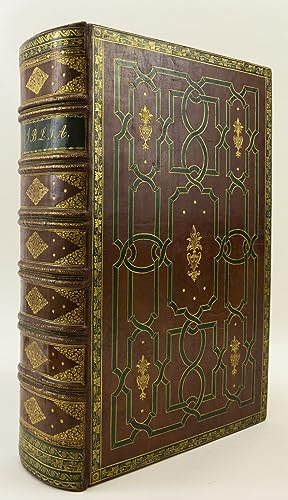
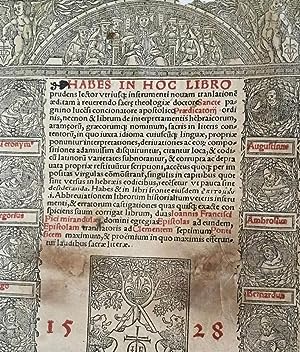
![Bild des Verkäufers für Biblia, das ist: Die gantze heilige Schrifft, verdeutschet durch D. Martin Luther [.]. zum Verkauf von Antiquariat INLIBRIS Gilhofer Nfg. GmbH](https://pictures.abebooks.com/inventory/md/md15401160632.jpg)
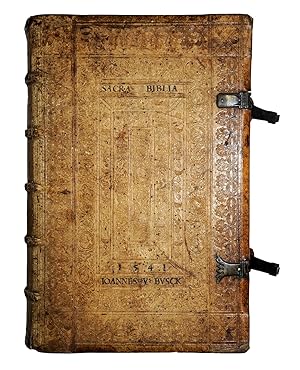
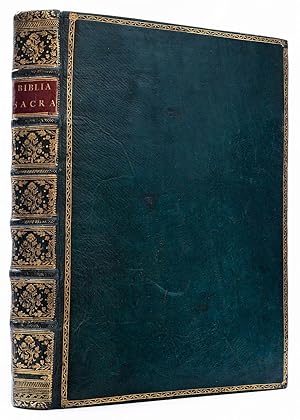
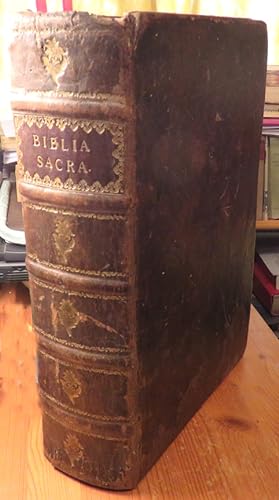
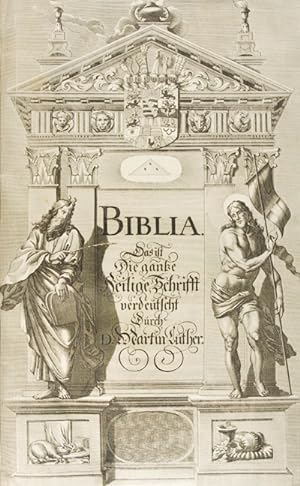
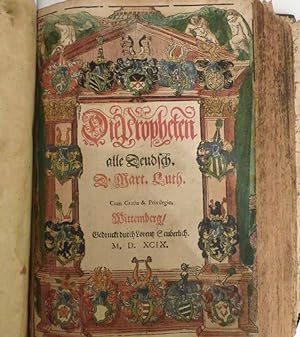
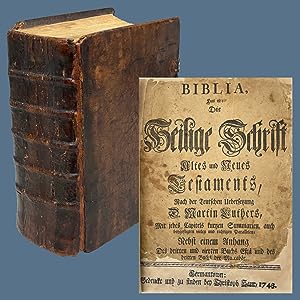
![Bild des Verkäufers für Biblia. das ist: Die gantze heilige Schrifft: Deudsch. D. Mart. Luth. [Luther Bible] zum Verkauf von Stony Hill Books](https://pictures.abebooks.com/inventory/md/md31309714622.jpg)
![Bild des Verkäufers für BIBLIA DAS IST: DIE GANTZE HEILIGE SCHRIFFT. DEUDSCH. D. MARTIN LUTHER. [THE GERMAN BIBLE IN LUTHER'S TRANSLATION] zum Verkauf von Phillip J. Pirages Rare Books (ABAA)](https://pictures.abebooks.com/inventory/md/md31052742817.jpg)
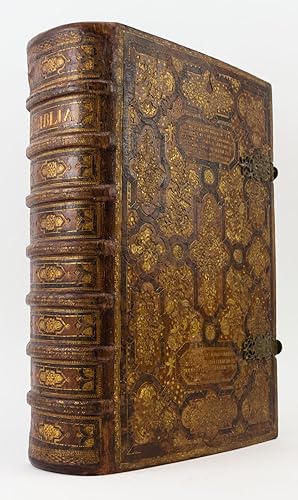
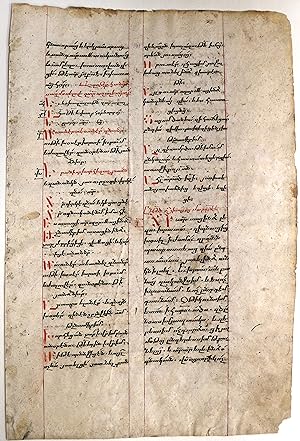

![Bild des Verkäufers für Sefer Kitve Ha-Kodesh: Torah Nevi'im U-Khetuvim 'Im Ha'atakah 'Ashkenazit [THE HEBREW BIBLE, IN HEBREW AND GERMAN, W/ ALL TEXT IN HEBREW SCRIPT] zum Verkauf von ERIC CHAIM KLINE, BOOKSELLER (ABAA ILAB)](https://pictures.abebooks.com/inventory/md/md22560302779.jpg)
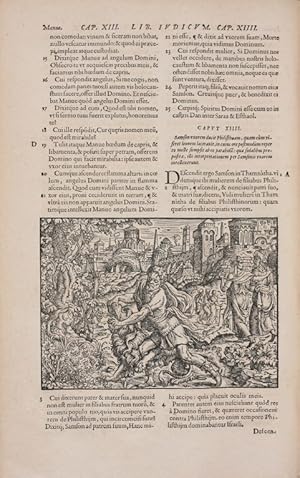
![Bild des Verkäufers für Biblia, Das ist: Die ganze Heilige Schrift Des Alten und Neuen Testaments. Bie Foide von Herrnn Doctor Martin Luther. [18th Century German Martin Luther Bible]. zum Verkauf von Raptis Rare Books](https://pictures.abebooks.com/inventory/md/md31578048549.jpg)
